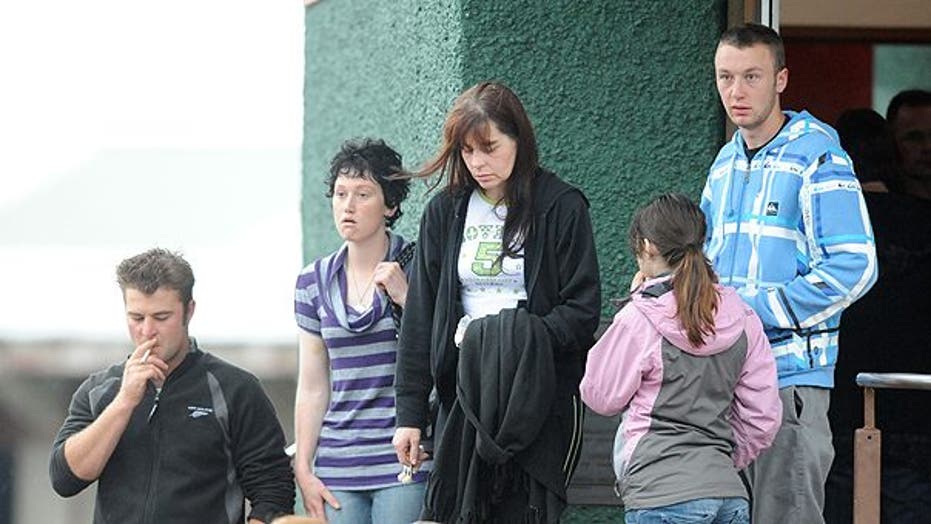GREYMOUTH, New Zealand -- Anguished relatives of 29 workers missing after an explosion at New Zealand coal mine grew frustrated over delays in the rescue operation Sunday, as officials prepared to drill a small hole through hundreds of feet of rock to test for levels of deadly gasses.
Nothing has been heard from the men who were deep in the mine near Atarau on South Island when a massive blast ripped through it late Friday. A working phone line to the bottom of the mine has been ringing unanswered.
Officials insisted Sunday they were hopeful the men were alive.
"The primary focus today is still a rescue operation," police superintendent Gary Knowles told reporters in the nearby town of Greymouth. "But it is still not safe to effect a rescue. When it's possible, we will go underground."
A 16-strong team of rescue experts have been held back from entering the mine by the buildup of poisonous gasses that could generate another explosion. The gases could be coming from a coal fire smoldering deep underground.
"We've got a heating of some sort underground and that means there's some combustion generating the gases that go with that, carbon monoxide, a slight increase in methane and some other gases," said Peter Whittal, the chief executive of Pike River Mine Ltd. "Something is happening underground, but what it is we don't know."
He said experts would drill a six inch-wide hole some 500 feet into the mine from the mountain above to enable rescuers to sample gas levels from deep in the mine's center. The process would take up to 24 hours.
Relatives voiced frustration over the delays in the rescue operation.
"If I had my way I'd be down there, I'd go into the mine myself," said Laurie Drew, whose 21-year-old son, Zen, is one of the missing men.
As he spoke to TV One, Drew wore his son's jacket. "I wore it so I can give it back to him when he comes out," he said, choking back tears. "I just want my boy home."
Police said the miners, aged 17 to 62, are believed to be about 1.2 miles (two kilometers) down the main tunnel.
Two men emerged after the explosion Friday, but there has been no word from the 29 others.
Fresh air is being pumped down an open air line into the mine.
"It is quite conceivable there is a large number of men sitting around the end of that open pipe waiting and wondering why we are taking our time getting to them," Whittall said on Saturday.
Electricity in the mine went out shortly before the explosion and that failure may have caused ventilation problems and contributed to a buildup of gas, officials have said.
Whittall said the blast was most likely caused by coal gas igniting.
The two dazed and slightly injured miners stumbled to the surface hours after the blast shot up the mine's 354-foot (108-meter)-long ventilation shaft.
The explosion occurred about 3:45 p.m. Friday. Video from the scene showed blackened trees and light smoke billowing from the top of the rugged mountain where the mine is located. It is New Zealand's largest underground coal mine.
Families of the missing men gathered in nearby Greymouth on Saturday, and were being briefed hourly on rescue efforts. Most have declined to talk to reporters, as have the two men who made it out of the mine. They are expected to be taken to the mine site on Sunday.
"There is a great sense of anxiety and genuine fear, and I think that's only natural given the difficulty of the situation," Prime Minister John Key told reporters after visiting the families. "We reflected to them that they have to hang on to hope. As we saw in the case of the Chilean mine, 33 miners did get out alive."
But unlike the accident in Chile, where 33 men were rescued from a gold and copper mine after being trapped a half mile (one kilometer) underground for 69 days, Pike River officials have to worry about the presence of methane, mine safety expert David Feickert said.
He added, however, that the Pike River mine has two exits, while the mine in Chile had only one access shaft that was blocked.
The coal seam at the mine is reached through a 1.4-mile (2.3-kilometer) horizontal tunnel into the mountain. The seam lies about 650 feet (200 meters) beneath the surface. The vertical ventilation shaft rises 354 feet (108 meters) from the tunnel to the surface.
Whittall said the horizontal tunnel would make any rescue easier than a steep-angled shaft, once safety is established.
Each miner carried 30 minutes of oxygen, enough to reach oxygen stores in the mine that would allow them to survive for several days.
But some said hope was fading for the men.
"The longer it drags on it doesn't look good, does it?" said local resident Shayne Gregg, who worked at the mine last year. "It's a feeling of hopelessness not ... being able to get there, but people are aware the mining industry is hazardous and has highs and lows."
Australian and British citizens were among the missing men, and Australia sent a team of mine rescue experts to assist the operation.
Australian Prime Minister Julia Gillard said Australia was anxiously waiting for news from the mine. British Foreign Secretary William Hague said he was saddened by the accident.
The 2-year-old Pike River mine is working largest-known deposit of hard coking coal in New Zealand, with 58.5 million tons.
New Zealand has a generally safe mining sector, with 181 people killed in 114 years. The worst disaster was in March 1896, when 65 died in a gas explosion. Friday's explosion occurred in the same coal seam.

